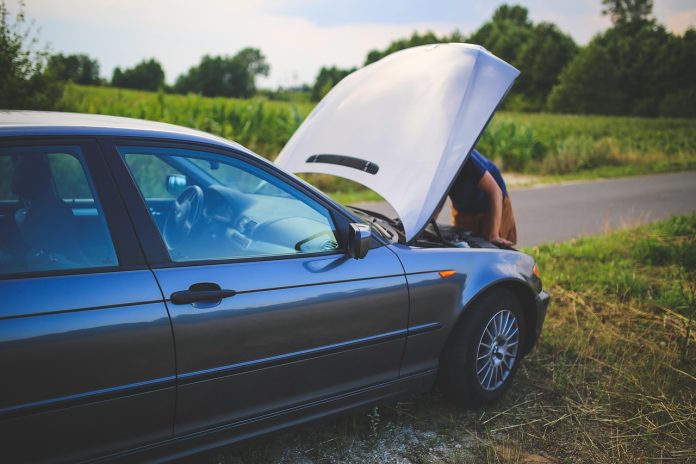- Stay calm and assess your safety and surroundings first.
- Try starting your car again after waiting a few minutes.
- Use a portable jump starter if no help is available.
- Look for a safe location to wait or get assistance.
- Learn alternative ways to reach emergency services when there’s no signal.
- Prevent future breakdowns with routine maintenance and supplies.
- Visit a well-reviewed battery store for all kinds of batteries to ensure quality replacements.
Introduction: When Your Battery Dies Far from Help
Imagine you’re on a scenic drive or camping trip in the middle of nowhere—and your car won’t start. No sound, no lights, just silence. A dead battery in a remote area can be scary, frustrating, and even dangerous if you’re not prepared.
This guide explains what to do if your car battery dies while you’re far from home or civilization. It covers safety steps, troubleshooting, emergency tools to carry, and how to prevent it from happening again.
Step 1: Stay Calm and Evaluate Your Surroundings
When your car suddenly won’t start, your first instinct might be to panic. But staying calm is the best first step.
Prioritize Safety
- Are you on a shoulder, in a parking lot, or on a dirt road? If your hazard lights are still working, turn them on.
- Check your surroundings: Are you near a road, forest, or exposed to wildlife?
- Remain inside the vehicle if it’s safer than being outside, especially in extreme weather or after dark.
If you’re in a risky area (e.g., on a steep shoulder or exposed road), move your vehicle out of danger if possible.
Step 2: Attempt to Start the Car Again
Sometimes, a car may not start immediately due to a temporary drain or electronic issues.
Try These First:
- Turn off everything: Radio, AC, headlights, and any plugged-in chargers.
- Wait a minute or two, then try to start the car again.
- If it cranks weakly but doesn’t start, the battery is likely the issue.
- If nothing happens — no sound, no lights — it’s very likely that the battery is completely dead.
Don’t keep cranking the engine repeatedly. This can further drain the battery and damage your starter motor.
Step 3: Use a Portable Jump Starter
A portable jump starter can save your trip—and possibly your life—in remote areas.
How to Use It:
- Connect clamps: Attach the red clamp to the battery’s positive terminal (+) and the black clamp to the negative terminal (–).
- Power on the jump starter.
- Try to start the car.
- If successful, let the engine run for at least 15–20 minutes to recharge the battery.
- Remove the clamps in reverse order and store the unit.
Note: Always read your jump starter’s user manual before using it.
If you don’t already have one, invest in a jump starter with a built-in flashlight, USB ports, and charging cables. It can make a huge difference in emergencies.
Step 4: Look for Signal or Assistance
If your car still won’t start and you’re alone without tools, you’ll need help. But that can be hard to find in remote places.
Options to Try:
- Check for cell service: Move to higher ground or away from thick tree cover.
- Use Wi-Fi calling or apps like Zoleo or Garmin inReach (if you have them) to send SOS messages.
- Send a friend or family member your last known location if you can.
- Ask a passing driver for help: If another vehicle passes, signal them safely and explain your situation.
If there’s no cell reception and no help in sight, prepare to wait safely.
Step 5: Stay Warm (or Cool) and Visible While Waiting
Depending on the weather and location, staying in your car can be the safest option.
Essentials to Have in the Car:
- Blankets or an emergency sleeping bag
- Water and snacks
- Reflective triangle or LED flares
- Battery-powered fan or hand warmers
- Flashlight or lantern with fresh batteries
- Fully charged power bank
If it’s hot, crack the windows slightly for airflow. In cold conditions, bundle up and avoid draining your battery further by turning on electronics.
Step 6: Know Alternative Ways to Call for Help
Cell signal might be weak or unavailable in remote areas. But there are alternatives:
Tools to Consider:
- Satellite communicators: Devices like Garmin inReach or SPOT Gen4 allow two-way text or SOS even without a cell network.
- CB radios or handheld radios are useful in areas with active radio traffic (like near parks or rural communities).
- Emergency roadside beacons: Can alert passing vehicles or rescuers with lights or distress signals.
Always keep your emergency contact info visible in your vehicle in case someone else comes across it.
Step 7: Once You’re Home, Replace the Battery Immediately
Even if you manage to restart your car, the battery may not be reliable anymore. You don’t want a repeat incident.
- Test the battery’s voltage and charging capability.
- If it’s more than 3 years old, it’s likely time for a new one.
- Visit a well-reviewed battery store for all kinds of batteries to ensure you get a quality, compatible product.
Many stores also test your old battery for free and offer installation.
Tools and Supplies to Always Keep in the Car
Being prepared is your best defense against breakdowns in remote areas.
Must-Haves for Battery Emergencies:
- Portable jump starter (fully charged)
- Jumper cables
- Flashlight and extra batteries
- Reflective vest and triangle
- First aid kit
- Blanket and water
- Emergency whistle or beacon
- Solar charger or power bank
- Multi-tool or basic tool kit
Store these items in a weatherproof emergency bag in your trunk. Check supplies every few months.
How to Prevent Battery Failure in the First Place
Your car battery is easy to overlook—until it fails. Most people don’t think twice about their battery until they’re stranded in a parking lot or stuck on the roadside. But with a few simple habits and periodic maintenance, you can greatly reduce the risk of unexpected battery failure and extend the overall lifespan of your battery.
Batteries are vulnerable to temperature changes, vibration, and slow discharge from electronics and accessories. Preventive care helps minimize these risks. The following tips can help you avoid the inconvenience and cost of premature battery replacement.
Maintenance Tips:
- Inspect the battery terminals for corrosion: Corrosion looks like a white, ashy buildup on the terminals and can block the flow of electricity. Clean with a wire brush and a baking soda–water solution to ensure good electrical contact.
- Tighten battery cables: Loose connections can interfere with proper power delivery, especially when driving on bumpy roads. Check the cables occasionally and tighten them if they feel wobbly or appear out of place.
- Test the battery twice a year: Ideally, test it before the extreme temperatures of summer and winter. Most auto parts stores or service centers can do this quickly and often for free.
- Drive regularly or use a trickle charger: If your car isn’t driven for long periods, the battery can slowly drain. A trickle charger helps maintain battery voltage when your car is parked for weeks at a time.
- Avoid leaving electronics or lights on: Something as simple as a dome light left on overnight can deplete your battery. Double-check that everything is off when exiting your vehicle.
- Get your battery checked during oil changes: Many shops now offer complimentary battery tests as part of routine maintenance. It only takes a few minutes and can catch a weak battery before it fails.
By following these simple preventative measures, you can avoid the hassle of emergency battery replacements and extend your battery’s useful life-saving money and reducing downtime in the long run.
Signs You May Be Heading for a Battery Emergency
Your battery rarely fails without warning. In most cases, your car gives subtle clues that something isn’t right. Recognizing these early signs can help you avoid getting stranded in an inconvenient—and potentially dangerous—location, especially in a remote area where help may not be readily available.
When your battery starts to fail, electrical systems struggle, and the engine may become harder to start. Ignoring these issues can quickly turn a minor inconvenience into a major problem. Being proactive is key.
Warning Signs:
- Slow engine cranking: If your engine turns over more slowly than usual or sounds like it’s struggling to start—especially in the morning or during cold weather—it’s a red flag. A weak battery doesn’t provide the power your starter needs.
- Flickering or dim dashboard lights: When starting your car, keep an eye on your instrument panel. If lights flicker or appear dim, it could indicate that your battery is losing its ability to hold a charge or deliver consistent power.
- Needing frequent jump-starts: If you find yourself reaching for jumper cables more than once every few months, your battery is no longer reliable. Repeated jump-starts mean it’s failing to hold a proper charge and needs immediate attention.
- Swollen battery casing: A bloated or misshapen battery is a serious warning sign. It often indicates that the battery has overheated or undergone internal damage. This can happen in extreme temperatures or from overcharging.
- Corrosion around terminals: White, green, or bluish buildup around the battery posts can disrupt electrical flow and reduce your battery’s effectiveness. While this can sometimes be cleaned, it often signals that your battery is aging.
- Dashboard warning lights: A battery-shaped icon or even a check engine light can signal issues with the battery or charging system. While not always battery-related, it should never be ignored.
If you notice any of these symptoms, don’t wait until your car won’t start. Take immediate action by testing your battery’s health or visiting a trusted service center. In many cases, a replacement is far cheaper—and safer—than waiting for an emergency.
What If It’s Not the Battery?
Sometimes, your car won’t start because of something else. Don’t misdiagnose the problem.
Could Be:
- Alternator issues: If your battery keeps dying, the alternator may not be charging it.
- Starter problems: Clicking noises but no crank could mean a faulty starter.
- Loose or corroded cables: Poor connections prevent the battery from doing its job.
- Fuel delivery problems: You may be out of gas or dealing with a bad fuel pump.
A professional diagnostic test can identify the issue if your battery appears fine.
Prepare Now, Not Later
A dead battery is always inconvenient—but when it happens in a remote location, it can be downright dangerous. Knowing what to do, having the right tools, and preparing for emergencies can turn a potentially serious situation into a manageable one.
Whether you’re an off-roading adventurer, a long-distance commuter, or just cautious about road trips, being ready for battery failure can save time, money, and stress.



